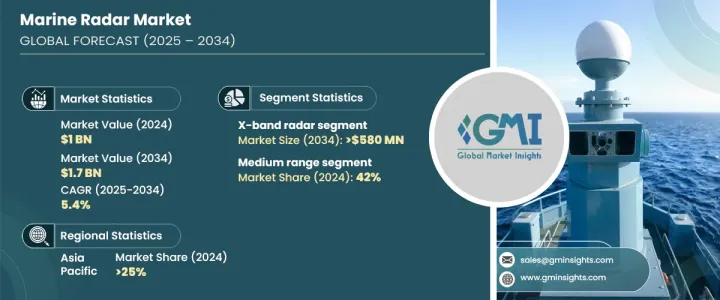
세계 해양 레이더 시장은 2024년에 10억 달러로 평가되었고, 2025년부터 2034년까지 CAGR은 5.4%를 나타낼 전망입니다.
해양 안전과 보안 우선순위가 높아짐에 따라 상업용 선박과 레저용 선박 모두에 필수적인 고급 레이더 시스템에 대한 수요가 증가하고 있습니다. 해상 활동의 확대와 세계 무역의 격화에 따라 정확한 항행과 충돌 회피 기술의 필요성이 급증하고 있습니다. 특히 피크시의 혼잡한 시레인에서의 선박 교통량 증가는 안전하고 효율적인 해상 운항을 확보하는 레이더 시스템의 중요성을 높이고 있습니다.

또한 고체 레이더와 고급 신호 처리와 같은 기술 진보가 감지 능력을 향상시키고 시장 채택을 더욱 촉진하고 있습니다. 정부와 민간단체는 예측 불가능한 기상 조건, 해적 위협, 중요한 항로의 혼잡 증가에 따른 위험을 줄이기 위해 최첨단 레이더 기술로 선대를 강화하고 해상 감시에 많은 투자를 하고 있습니다. 또한 인공지능과 머신러닝을 해양 레이더 시스템에 통합함으로써 예측 분석이 강화되고 항해가 보다 정확해지고 인적 실수가 줄어듭니다. 이러한 혁신은 레이더 시스템의 사용을 의무화하는 엄격한 해양 규제와 함께 향후 10년간 시장 확대를 촉진할 것으로 예상됩니다.
| 시장 범위 | |
|---|---|
| 시작 연도 | 2024년 |
| 예측 연도 | 2025-2034년 |
| 시작 금액 | 10억 달러 |
| 예측 금액 | 17억 달러 |
| CAGR | 5.4% |
이 시장은 X 밴드, S 밴드, 솔리드 스테이트 모델 등 다양한 레이더 시스템으로 구성되어 있습니다. 2024년에는 X밴드 레이더 분야가 37%의 점유율을 차지했으며, 2034년에는 5억 8,000만 달러에 달할 것으로 예측됩니다. 고해상도 이미지, 뛰어난 단거리 감지, 다양한 해양 환경에의 적응성에 의해 혼잡한 해역을 항행하는 선박으로 선택되고 있습니다. 8-12GHz의 주파수 대역에서 동작하는 X밴드 레이더는 인근의 선박이나 부유물, 악천후 등의 작은 물체의 식별이 뛰어납니다. 이 능력은 안전한 조종에 높은 정확성이 필수적인 항만, 해안 지역 및 해상 시설에서 항해하는 데 특히 중요합니다.
해양 레이더 시장은 단거리, 중거리, 장거리 시스템 등 감지 범위에 따라 구분됩니다. 중거리 레이더 부문은 범용성, 비용 효율성 및 강력한 성능에 견인되었으며 2024년에는 시장의 42%를 차지했습니다. 상업 선박, 어선 및 유어선에서 널리 사용되는 이러한 시스템은 안정적인 감지를 제공하여 운영 효율성과 안전성을 높입니다. 해안지역과 교통량이 많은 항로의 감시에 유효하기 때문에 해상 업무에 필수적입니다. 세계의 해운활동의 활성화와 해외 에너지 프로젝트의 확대에 따라 중거리 레이더 수요는 향후 수년에 더 늘어날 것으로 예상됩니다.
2024년 시장 점유율은 아시아태평양이 25%를 차지하며 중국이 압도적인 존재감을 보여줍니다. 세계 무역에서의 이 나라의 역할 확대와 항만 인프라와 조선에 대한 많은 투자가 해양 레이더 시스템 수요에 박차를 가하고 있습니다. 세계 유수의 수출국이자 국제 물류, 해운업계의 중요한 거점인 중국은 이 분야의 성장을 계속 견인하고 있습니다. 해양 안보 강화를 목적으로 한 정부의 대처가 증가하고, 상용 및 방위용도로 차세대 레이더 기술의 채용이 진행되고 있기 때문에 해양 레이더 시장의 확대에 크게 공헌하는 국가로서의 지위가 더욱 강화되고 있습니다.
The Global Marine Radar Market, valued at USD 1 billion in 2024, is poised for steady growth, with a projected CAGR of 5.4% from 2025 to 2034. The increasing prioritization of marine safety and security is fueling demand for advanced radar systems, essential for both commercial and recreational vessels. As maritime activities expand and global trade intensifies, the need for accurate navigation and collision avoidance technologies has surged. Rising vessel traffic in busy sea lanes, especially during peak periods, has heightened the importance of radar systems in ensuring safe and efficient maritime operations.

Moreover, technological advancements, such as solid-state radar and enhanced signal processing, are improving detection capabilities, further driving market adoption. Governments and private entities are investing heavily in maritime surveillance, strengthening their fleet with state-of-the-art radar technology to mitigate risks associated with unpredictable weather conditions, piracy threats, and increasing congestion in critical shipping routes. Additionally, the integration of artificial intelligence and machine learning into marine radar systems is enhancing predictive analytics, making navigation more precise and reducing human error. These innovations, along with stringent maritime regulations mandating the use of radar systems, are expected to propel market expansion over the next decade.
| Market Scope | |
|---|---|
| Start Year | 2024 |
| Forecast Year | 2025-2034 |
| Start Value | $1 Billion |
| Forecast Value | $1.7 Billion |
| CAGR | 5.4% |
The market comprises various radar systems, including X-band, S-band, and solid-state models. In 2024, the X-band radar segment dominated with a 37% share and is projected to reach USD 580 million by 2034. Its high-resolution imaging, superior short-range detection, and adaptability to diverse marine environments make it the preferred choice for vessels operating in congested waters. Operating within the 8-12 GHz frequency range, X-band radar excels in identifying small objects like nearby vessels, floating debris, and even adverse weather conditions. This capability is particularly crucial for navigation in harbors, coastal areas, and offshore installations, where high accuracy is essential for safe maneuvering.
The marine radar market is also segmented by detection range, including short-range, medium-range, and long-range systems. The medium-range radar segment accounted for 42% of the market in 2024, driven by its versatility, cost-efficiency, and strong performance. Widely used on commercial ships, fishing boats, and recreational vessels, these systems provide reliable detection, enhancing operational efficiency and safety. Their effectiveness in monitoring coastal zones and heavily trafficked shipping routes makes them indispensable for maritime operations. With increasing global shipping activities and the expansion of offshore energy projects, demand for medium-range radars is expected to grow further in the coming years.
Asia-Pacific held a 25% market share in 2024, with China emerging as a dominant player. The country's expanding role in global trade, coupled with heavy investments in port infrastructure and shipbuilding, has fueled demand for marine radar systems. As the world's leading exporter and a key hub in the international logistics and shipping industry, China continues to drive growth in this sector. Increasing government initiatives aimed at bolstering maritime security and the adoption of next-generation radar technology across commercial and defense applications further reinforce its position as a major contributor to the marine radar market expansion.